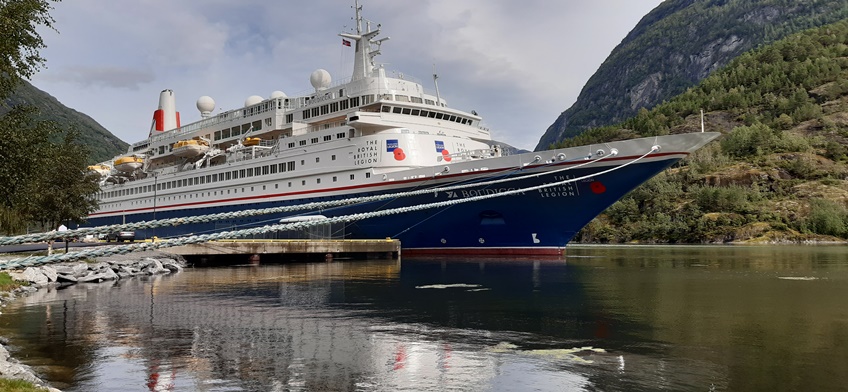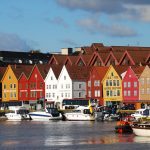An old ship’s steering displayed just below the bridge wing of Fred. Olsen’s former cruise ship MV Boudicca, captured my imagination.
I spotted it soon after she had cast off from the Liverpool Cruise Terminal and nosed her way out into the River Mersey en route for the open sea and a cruise along the coast of Northern Spain.
Wheels are often so evocative as they represent life’s tendencies for turning full circle or of signifying some change of fortune, which has certainly been the case for the world’s cruise industry since the arrival of coronavirus.
So just why was that traditional old wooden spoked wheel on display? I wondered.
The answer, I soon discovered, was because it was the ship’s original when she and her consort Black Watch first sailed out of a Helsinki yard on their sea trials back in the spring of 1972 prior to joining the Royal Viking fleet.
Now here we are, more than fifty years on and both iconic vessels, which played such an integral part in Fred. Olsen’s cruise programme in recent years, along with their consort’s Balmoral and Braemar, have been retired.
They have not been scrapped, always good news for a shiplover, but are taking on a new lease of life with a Turkish ship management company as accommodation vessels in support of large- scale projects.
I last saw Black Watch and Boudicca together in 2018 when they rendezvoused with Balmoral and Braemar for a reunion in Cadiz.

I had sailed in on Black Watch following a voyage from Liverpool to the Azores and Madeira.
Making landfall on these remote islands had always been an ambition of mine since schoolboy days when I read that it was at Flores in the Azores that Sir Richard Grenville had fought off the mighty Spanish fleet in The Revenge, an heroic ballad by Alfred Lord Tennyson.
Similarly, first catching sight of Cadiz from high above the Black Watch bow, also held another schoolboy memory for me because, of course, it was here that the swashbuckling Sir Francis Drake had “singed the King of Spain’s beard” by sending in a fire ship to destroy his fleet.
The Fred. Olsen cruise ship rendezvous at Cadiz was in its way also an historic affair, because it was only the second time in the Norwegian company’s long maritime history that all its ships were in the same port at the same time and was marked by a day of celebrations.
But as the four vessels sailed in convoy out of the historic Spanish port at the end of that glorious summer afternoon, who could have foreseen the storm which would soon gather over the horizon to rock the world-wide cruise industry.
Over the previous decade the industry had experienced unparalleled growth with passenger numbers increasing from around seventeen million to circa twenty-nine million by 2019.
The business employing around sixty- six thousand overall at sea and on land and being worth some £2.5 billion to the UK economy alone.
The passenger numbers were looking set to rise to some thirty- two million before the pandemic struck and cruising was suspended world- wide from March to July last year.
But Fred. Olsen, still looking positively to the future went ahead with its acquisition of the former Holland America Line ships Amsterdam and Rotterdam and renamed them Bolette and Borealis.
While it is planned that with pandemic restrictions easing, Bolette, Borealis and Balmoral will commence their new cruise programmes in July with a series of sailings around the British Isles, Braemar will begin her departures from next spring.
As an interesting link with the past, Bolette, which was launched in 2000 and can carry 1,338 passengers, was named after the great, great grandmother of the company’s Chairman Fred Olsen Junior, who attended the Cadiz reunion celebrations.
A wooden church which she built and gifted to the people of her home town of Hvitsen, still stands today.
Bolette’s consort Borealis is slightly older, being launched in 1996 and she carries 1,360 guests.
Prior to the pandemic, Fred. Olsen sailed out of Liverpool, Dover, Southampton and Rosyth but now the departure ports have been extended to include, London Tilbury, Portsmouth and Belfast so giving it more than any other operator.
But back in April last year, the enterprising company launched a virtual cruise of the Norwegian fjords, one of its most popular destinations to soften the blow for disappointed guests unable to sail.
It certainly brought back some scenic memories from my 2019 cruise in MV Boudicca.
This was followed up by over fifty more with destinations including Iceland, the Caribbean and the Canary Islands and then by sneak previews inside Bolette and Borealis.
So just what the three Olsen brothers who launched the original company in Hvitsen on Norway’s Oslofjord back in 1848 would make of all of this, one can only speculate.
But suffice is to say that like that original ship’s wheel displayed below Boudicca’s bridge wing, one hope’s the cruise industry’s fortunes will soon be turning for the better just beyond the Covid horizon.
Nigel Heath, Mature Times Travel Writer




